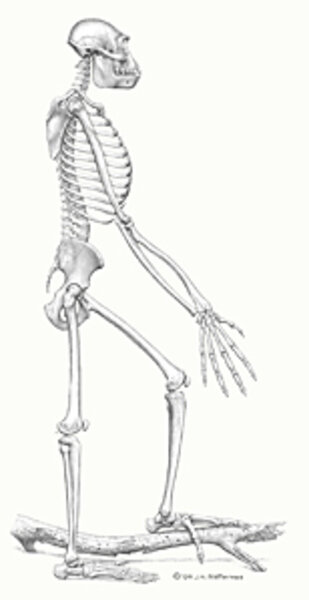Fossil upends theories about evolution of human ancestors
Loading...
Scientists in Ethiopia have found a 4.4 million year old human predecessor that promises to upend long-held notions of what the common ancestor of African apes and humans looked like, how it lived, and how much both lineages have evolved since diverging.
The species, called Ardipithecus ramidus, is one million years older than "Lucy," the famous partial female skeleton of a hominid that lived 3.2 million years ago and was previously the closest scientists had come to finding the common ancestor of apes and humans. Modern genetic analysis suggests that the lineages of chimpanzees and Homo sapiens diverged more than 6 million years ago.
The discovery, published in Friday's issue of the journal Science, is a seminal find in a scientific quest that began when Charles Darwin first posited that humans and apes were descended from a common ancestor. Ever since, anthropologists have wondered what this progenitor might have looked like.
Now, the new find brings them closer than ever before. It also indicates that several assumptions about what that common ancestor looked like were off.
"What we're seeing here is something that we never could have predicted from either a modern human or a modern chimpanzee," said Tim White, a professor at the University of California in Berkeley and coauthor of several of the papers in Science, in an online video presentation. "The only way to learn about this creature is through the paleontological record."
"Ardi" inhabited woodlands in what's now Ethiopia during the Pliocene epoch. What is most remarkable about the find is that Ardi resembles neither apes nor humans. Previously, many anthropologists had thought that the apes of today were relatively unchanged from the common ancestor of 6 million years ago, and it was the hominid line alone that evolved.
As a result, it was frequently posited that the common ancestor would look like an ape. Now, it appears that approach may be more misleading than illuminating.
If Ardi resembles the common ancestor of humans and apes, then apes must have evolved much more than previously thought since separating from hominids.
"It really doesn't look like we evolved from chimpanzees," says Carol Ward, an anatomical scientist at the University of Missouri in Columbia. "They've been evolving, too."
Ardi weighed 110 lbs. and measured about four feet tall. She (the most complete skeleton recovered was female) had a chimp-sized brain and a grasping big toe like modern apes. But unlike modern apes, she had a flexible back, more like Homo sapiens. And while she could climb trees better than Lucy, who was adapted to the savanna and could walk on two feet, she couldn't swing from branches as well as chimpanzees because she lacked apes' hook-shaped hands.
Her hand and wrist bones indicate that she didn't knuckle-walk like modern gorillas and chimps, either. Rather, when in trees, she strolled atop branches on all fours as monkeys do, the authors surmise. And when on the ground, she walked on two feet.
Ardi's apparent ability to walk on two feet challenges another storied notion about the hominid lineage. Some think that Lucy's ancestors began walking upright as grassland encroached on woodland during a period of climate change. But if Ardi was already bipedal before leaving the woods, then grasslands clearly didn't cause hominids to walk upright.
As Dr. Ward puts it, "The question we need to be asking is not 'Why did our ancestors stand up?' but 'Why did they never drop down on all fours on the ground?'"
Ardi's diminutive canine teeth present another mystery. They're smaller than those of modern apes, more like Lucy's and Homo sapiens'. That raises questions about early hominid social life. Male chimps and gorillas use their large canines as weapons in competition for females. But Ardi's small canines, combined with almost no body size difference between males and females, suggest that males didn't fight with each other for access to females, say the authors.
Ardi may have been monogamous, they say, a rarity in the animal kingdom.
Ward is skeptical of this conclusion. Yes, sexual dimorphism – the fact that males and female have different sizes and characteristcs – indicates that males compete for females, she says. But a lack of dimorphism doesn't mean the opposite – a lack of competition.
"Less social strife is very much an interpretation, and needs more testing," she says.





